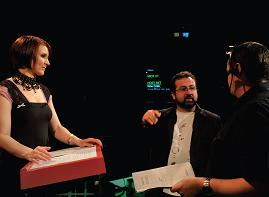Sleuth 101: re-inventing the game show genre
 The creators of Spicks and Specks are back with a new offering that combines murder mystery, comedy and game show. Encore joined them in Melbourne to discuss their new format, Sleuth 101.
The creators of Spicks and Specks are back with a new offering that combines murder mystery, comedy and game show. Encore joined them in Melbourne to discuss their new format, Sleuth 101.
Comedians are known for their analytical skills, which help them make the poignant and witty observations people pay them to hear. But that doesn’t necessarily make them the first people you’d call to solve a murder mystery, unless you’re on the ABC’s new Friday night show, Sleuth 101.
The concept was created by series producer Anthony Watt and executive producer Bruce Kane for Mayhem TV. Watt and Kane worked on the ABC’s successful music quiz show Spicks and Specks, and noticed the emergence of similar programs, featuring panels and people sitting down. They realised there was a need for something a little more ‘physical’ and decided to go beyond a traditional game show by incorporating a scripted narrative portion to its structure, as well as an element of improvisation.
“I was always a fan of mystery, so a whodunit kind of show suggested itself and we thought, how can we turn that into a game show?” said Watt.
“The idea of using comedians was very attractive to us, to get people that we worked with on Spicks and Specks to solve the crime,” added Kane.
CRIME AS COMEDY
Every one of the eight thirty-minute episodes begins with a dramatised murder, presenting four suspects and setting up the week’s mystery. Following the titles sequence the show moves indoors to the ABC’s Melbourne studios, where the murder scene has been carefully recreated for the guest ‘detective’ to analyse the clues and interrogate the suspects.
The show is presented by New Zealand-born stand-up comedian and Nova radio host Cal Wilson, who was chosen because of her connection with comedy-loving audiences.
“She’s very funny and quite loud, and she’ll bring that audience with her,” explained Watt. “But mystery tends to appeal to older audiences as well. In the same way that Spicks and Specks has never aimed at one demographic and grandparents watch it with their children, we’re looking for a similar kind of audience here.”
It was essential for the producers to find the right tone for the show, and making sure that it was maintained through both the dramatised and studio segments. The fact that both are directed by John Olb makes it easier to keep continuity between them, and his experience directing sketches (Fast Forward, Full Frontal) is also an asset in developing the comedy.
Watt says he wanted to modernise the whodunit concept by incorporating elements of forensic science, but keeping it as a family-oriented PG program.
“It’s not CSI with guts and blood. The 10-minute drama element is definitely on a comedy tone; [BBC mystery series] Jonathan Creek does it well because although there are often serious subjects, it’s definitely a comedy.”
The tone had to be integrated into the look of the series.
Penny Southgate designed a set that Watt defines as “very hightech, a tongue-in-cheek take on CSI”, which is married to the prerecorded segments shot by DOP Frank Racina.
“Each story suggests a different look, anything from Midsomer Murders to NCIS,” said Watt.
The scripted segments were written by Watt and Brendan Luno over 16 weeks. Although Watt says he’d like to do an episode set in a different era, the first series presents self-contained stories in contemporary settings, from a MasterChef parody to a recording studio, a gym or an office. Dale Mark’s art department was in charge of the creation and recreation of the murder scenes.
“They’re all interiors, due to the limiting nature of a whodunit with only four suspects, and the fact that we have to match the location in the studio,” said Watt.
The nine-week shoo the crew work two days on location for each episode, two in one week, followed by studio days the next week. In total, each episode took three days to shoot.
LIGHT ENTERTAINMENT
A great part of the show’s success depends on the producers’ choice of ‘detectives’: Frank Woodley, Hamish Blake, Julia Morris, Adam Richard, Dave O’Neil, Peter Rowsthorn, Claire Hooper and Colin Lane.
“The comedy has to be relevant to the plot and feel of the show,” explained Kane. “Some folk need assistance with that, and they often need to be briefed.”
The brief, adds Watt, is about understanding the mechanics of the show, so that it doesn’t become a series of gags.
“That way, they’re working towards the whole show. And even if the guest comedian is not at all funny, we still have a good mystery show. That’s safe for us, because we know we always have something good in the background.”
Kane would not disclose the budget for Sleuth 101, but he did provide a formula to speculate about it.
“Half a drama shoot + half an episode of Spicks and Specks = the cost of Sleuth 101,” he said. “10 minutes worth of drama plus 20 minutes of light entertainment.”
He calls it ‘light entertainment’ because, although shot in front of a live studio audience, it doesn’t feature audience participation and people can’t aspire to be contestants, a defining feature of the game genre. The incentive for audiences at home to watch, beyond the fantasy of participating in the show themselves, is the humour.
“The value is that you get to see people improvising. When you put comedians under pressure, trying to solve a crime, they come up with fantastic jokes. That to us is fascinating,” said Watt.



